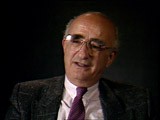You searched for: hiding
<< Previous | Displaying results 1-25 of 499 for "hiding" | Next >>
-
Jewish girls in hiding in a convent
PhotoA group of Jewish girls hiding, under assumed identities, in a convent. Ruiselede, Belgium, 1943-44.
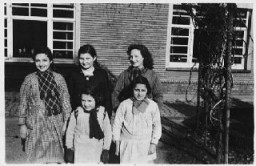
-
Augusta Feldhorn in hiding
PhotoAugusta Feldhorn stands next to a nun while in hiding. Augusta, a Jewish child, was in hiding under an assumed Christian identity. Belgium. 1942-1945.
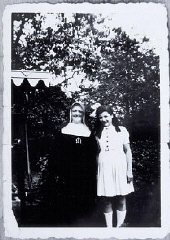
-
Hiding in disguise as a priest
PhotoAn Italian Jew who survived the war by disguising himself as a priest and living in the Vatican from October 1943 to June 1944. A number of Jews were able to seek refuge in religious houses throughout Rome, including in the Vatican. Rome, Italy, 1943-1944.
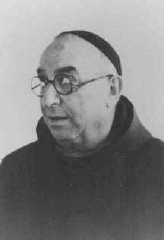
-
Identity Card Used in Hiding
Timeline EventAugust 3, 1943. On this date, Kurt I. Lewin was issued a forged ID card for "Roman-Paul Mytka." He used that identity to survive the war.
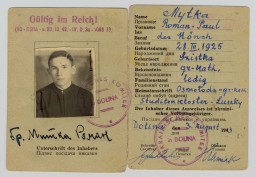
-
Hiding under a different religion
PhotoSome Jewish children survived the Holocaust because they were protected by people and institutions of other faiths. Children quickly learned to master the prayers and rituals of their "adopted" religion in order to keep their Jewish identity hidden from even their closest friends. This photograph shows two hidden Jewish children, Beatrix Westheimer and her cousin Henri Hurwitz, with Catholic priest Adelin Vaes, on the occasion of Beatrix's First Communion. Ottignies, Belgium, May 1943.
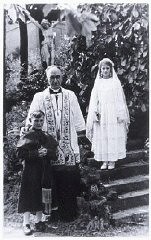
-
Dawid Tennenbaum in hiding
PhotoIn 1942, eleven-year-old Dawid Tennenbaum went into hiding with his mother, settling in the Lvov region as Christians. Dawid disguised himself as a girl and as mentally disabled. This exempted him from attending school and prevented his being exposed.

-
Dress Worn by a Child in Hiding
ArtifactA child's dress embroidered with red and blue flowers with small green leaves. This dress was hand embroidered by Lola Kaufman's mother in the Czortkow ghetto. Lola (born Lea Rein) wore this dress when she went into hiding. Lola was hidden first under a bed in the house of the woman who used to deliver milk to the family, then in a dugout under a cellar of a barn where she joined three other Jews in hiding. In March 1944, the Soviets liberated the area. The hidden Jews left their hideout in the middle of…
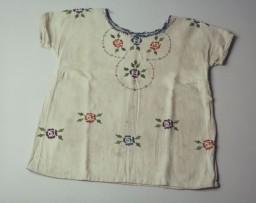
-
Child's Sweater Worn in Hiding
ArtifactDuring the 1943 liquidation of the Lvov ghetto, dozens of Jews fled into the city sewers to escape death. Eight-year-old Krystyna Chiger (later Kristine Keren) hid with her family and 16 others beneath the city's streets for 14 months, during which she wore this sweater.

-
Selma Schwarzwald in hiding as a Polish Catholic
PhotoSelma Schwarzwald poses outside while wearing her first communion dress. Selma lived in hiding as a Polish Catholic during the war. Busko-Zdroj, Poland, 1945.
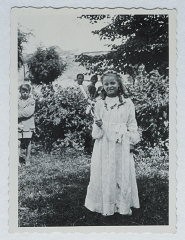
-
Letter Asking for Help to Hide Daughter
Timeline EventFebruary 1, 1943. On this date, Selek and Eda Kuenstler wrote to Sophia Zendler and begged her to hide their child.
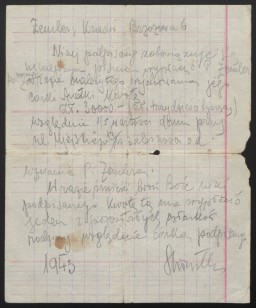
-
Drawing of shoes by a Jewish teenager in hiding
ArtifactJewish teenager Ava Hegedish drew this poignant picture of her mother's well-worn shoes while in hiding. It was drawn while Ava was in hiding at a farm near Belgrade, Yugoslavia (now Serbia), between 1941 and 1944. Once Nazi Germany and its Axis partners partitioned Yugoslavia and Belgrade fell under German control, Ava’s father thought the family’s best chance of survival was to separate and go into hiding. Ava ended up at a farm with some extended-family Serbian relatives. Because she…
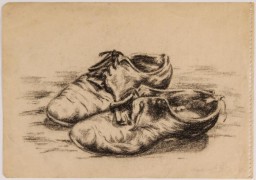
-
Sam Spiegel describes hiding in woods before liberation
Oral HistoryIn 1942, Sam was forced into a ghetto in his hometown and assigned to work in a munitions factory. In 1944 he was transported to Auschwitz and then forced to work in a train factory. He survived eight days on a death march after the evacuation of Auschwitz by the Nazis. He was liberated by Soviet units in January 1945. He lived in a displaced persons camp in Germany where worked for the United Nations Relief and Rehabilitation Administration. In 1947, he immigrated to the United States.

-
Yugoslav Jews in hiding
PhotoMr. Mandil and his son Gavra, Yugoslav Jews, while in hiding. The Mandil family escaped to Albania in 1942. After the German occupation in 1943, Mandil's Albanian apprentice hid the family, all of whom survived. Albania, between 1942 and 1945.
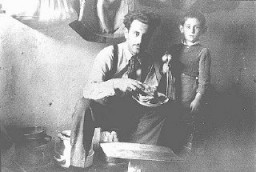
-
Jerry von Halle describes hiding in Amsterdam
Oral HistoryIn 1933 Jerry's family moved from Hamburg to Amsterdam. The Germans invaded the Netherlands in 1940. In 1941, Jerry's brother perished in Mauthausen. Jerry and his parents went into hiding first in Amsterdam and then in a farmhouse in the south. The Gestapo (German Secret State Police) arrested Jerry's father in 1942, but Jerry and his mother managed to return to their first hiding place. They were liberated in Amsterdam by Canadian and Jewish Brigade troops.
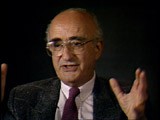
-
Anita Magnus Frank describes hiding in the Netherlands
Oral HistoryWhen the war began, Anita and her family lived in Breda, the Netherlands. With the 1940 German occupation, they went into hiding and took on new names that shielded their Jewish identity. Anita and her brother first were hidden in a non-Jewish neighbor's home, and later by a Quaker family near Utrecht. Anita, her parents, brother, and two sisters survived the war.

-
Hetty d'Ancona Deleeuwe describes difficulties of going into hiding
Oral HistoryThe Germans invaded the Netherlands in May 1940. After a year or so, Hetty and other Jewish children could no longer attend regular schools. The Germans took over her father's business in 1942. Hetty's father tried to prove that the family was Sephardic, and they were thus exempted from a roundup in 1943. Hetty's father decided that the family should leave Amsterdam, and Hetty was hidden with a family in the southern Netherlands. She and both her parents survived.

-
Felix Horn describes a hiding place in Warsaw
Oral HistoryFelix was born to an assimilated Jewish family in Lublin, Poland. His father was a locksmith and his mother was a singer. Following the German invasion of Poland on September 1, 1939, Felix fled east to Rovno and then to Soviet-occupied Lvov, where he was accepted at a medical school. After the German invasion of the Soviet Union in June 1941, Felix was taken to a labor camp. He escaped and returned to Lublin, and found that his family had been forced into the ghetto established there. After the…

-
Fred Deutsch describes conditions in hiding place in forest
Oral HistoryFred was born in Czechoslovakia in a town near the Polish border. Fred and his family were forced by the Germans to relocate east to a town bordering Slovakia. At the end of 1942, they escaped from the town and went into hiding. The family hid in bunkers in the forest until the end of the war. They moved every few weeks to avoid detection by the Germans or Slovak authorities. While the family was in hiding, Fred's grandfather made arrangements for Fred to attend school under an assumed name and religion. A…
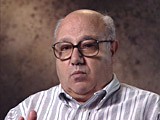
-
Fred Deutsch describes some of the risks involved in hiding
Oral HistoryFred was born in Czechoslovakia in a town near the Polish border. Fred and his family were forced by the Germans to relocate east to a town bordering Slovakia. At the end of 1942, they escaped from the town and went into hiding. The family hid in bunkers in the forest until the end of the war. They moved every few weeks to avoid detection by the Germans or Slovak authorities. While the family was in hiding, Fred's grandfather made arrangements for Fred to attend school under an assumed name and religion. A…

-
House in Amsterdam with a specially constructed hiding place
PhotoThe house in Amsterdam where Tina Strobos hid over 100 Jews in a specially constructed hiding place. Her house was raided eight times, but the Jews were never discovered. Netherlands, date uncertain.
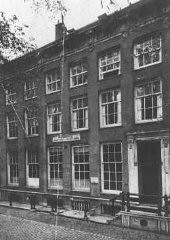
-
Beads used by a Dutch Jewish girl in hiding
ArtifactThese tiny black, white, gold, and clear glass beads were used by Rachel “Chelly” de Groot from November 1942 to April 1944 and recovered by her brother Louis after the war. Chelly used the beads to make handicrafts. On November 16, 1942, Chelly, then 15, Louis, 13, and their parents Meijer and Sophia left Arnhem and went into hiding after the Dutch police warned them of a raid. Meijer and Sophia hid in Amsterdam while Chelly and Louis moved around to different locations. In summer or fall 1943,…
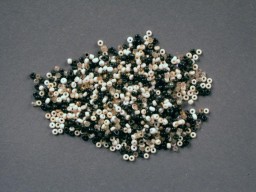
-
Selma Engel diary entry about life in hiding
ArtifactDiaries reveal some of the most intimate, heart-wrenching accounts of the Holocaust. They record in real time the feelings of loss, fear, and, sometimes, hope of those facing extraordinary peril. Selma Wijnberg and Chaim Engel met and fell in love in the Sobibor killing center. After the young couple made a daring escape during the camp uprising and fled into hiding, Selma began a diary to record their experiences. The diary was written in 1943-1944 while Selma was in hiding in German-occupied…

-
Suse Gruenbaum Schwarz describes preparation for and hiding during a Nazi raid
Oral HistorySuse's family moved to the Netherlands in 1933. After invading the Netherlands in 1940, the Germans imposed anti-Jewish measures. From 1942, Suse could not attend school. The family went into hiding in 1943, Suse and her mother on one farm and her father on another. Later, her father and another couple came to hide with Suse. They were liberated in 1945. Suse arrived in the United States in 1947.

-
Carla Heijmans Lessing describes the fear her family felt while in hiding
Oral HistoryAfter invading the Netherlands in 1940, the Germans imposed anti-Jewish measures. With the aid of a Catholic priest who helped Jews find hiding places, Carla, her mother, and her brother went into hiding in August 1942 to avoid deportation to work camps. They had to leave the hiding place after three months and with the priest's help found shelter in Delft with a Catholic family which had seven children. They remained in hiding there for 30 months, until liberation in May 1945.

-
Jerry von Halle describes hunger while in hiding in Amsterdam
Oral HistoryIn 1933 Jerry's family moved from Hamburg to Amsterdam. The Germans invaded the Netherlands in 1940. In 1941, Jerry's brother perished in Mauthausen. Jerry and his parents went into hiding first in Amsterdam and then in a farmhouse in the south. The Gestapo (German Secret State Police) arrested Jerry's father in 1942, but Jerry and his mother managed to return to their first hiding place. They were liberated in Amsterdam by Canadian and Jewish Brigade troops.
